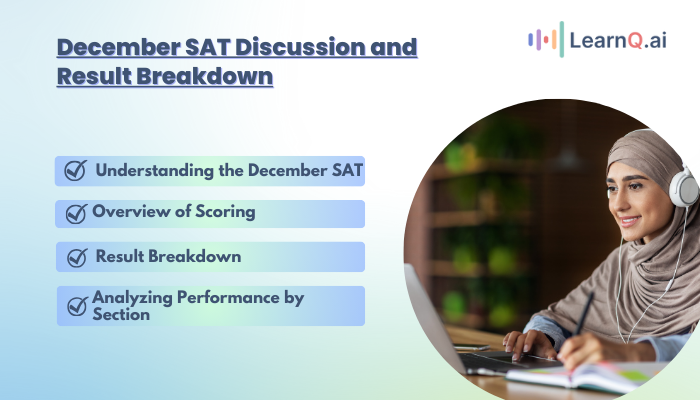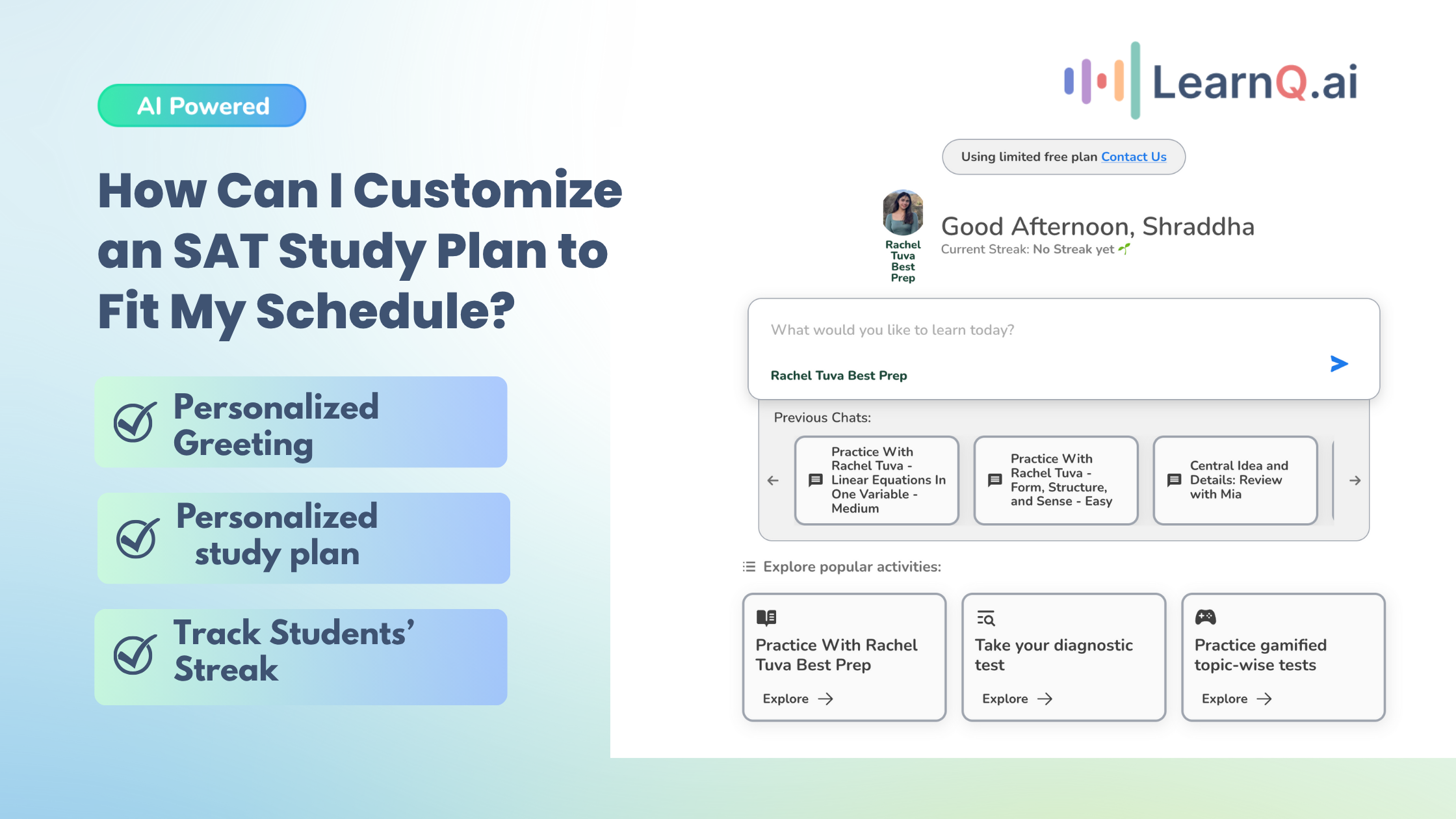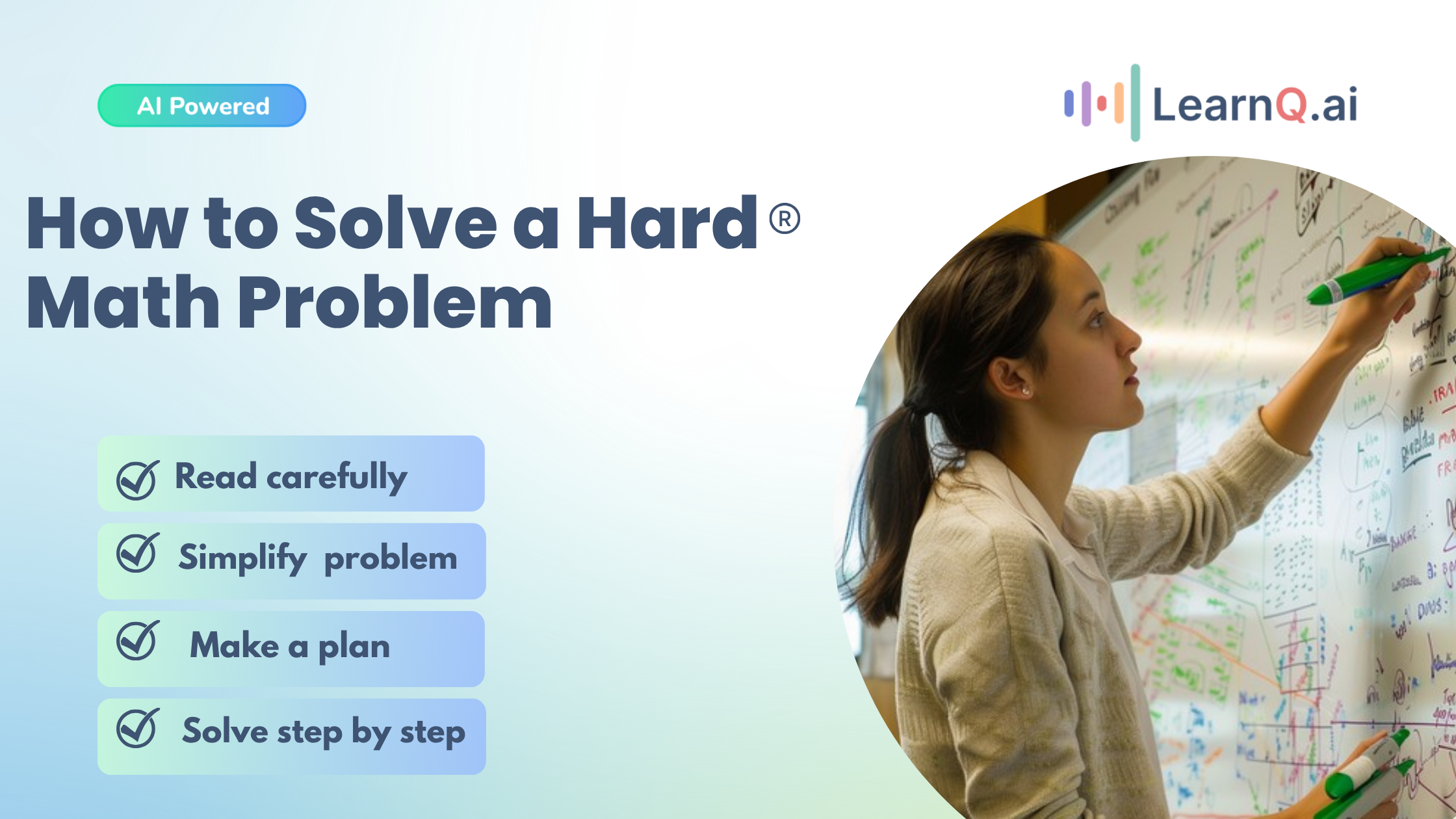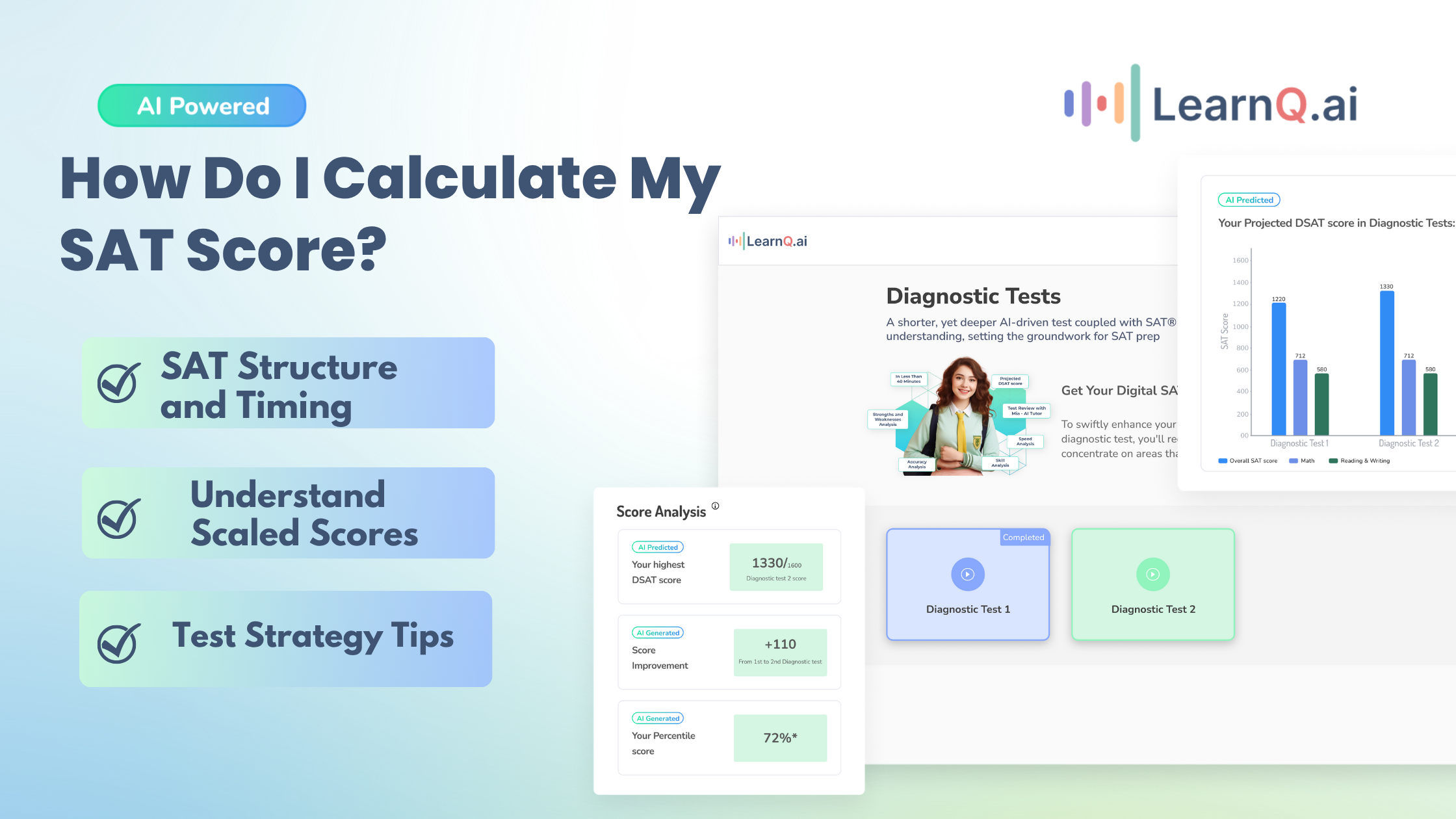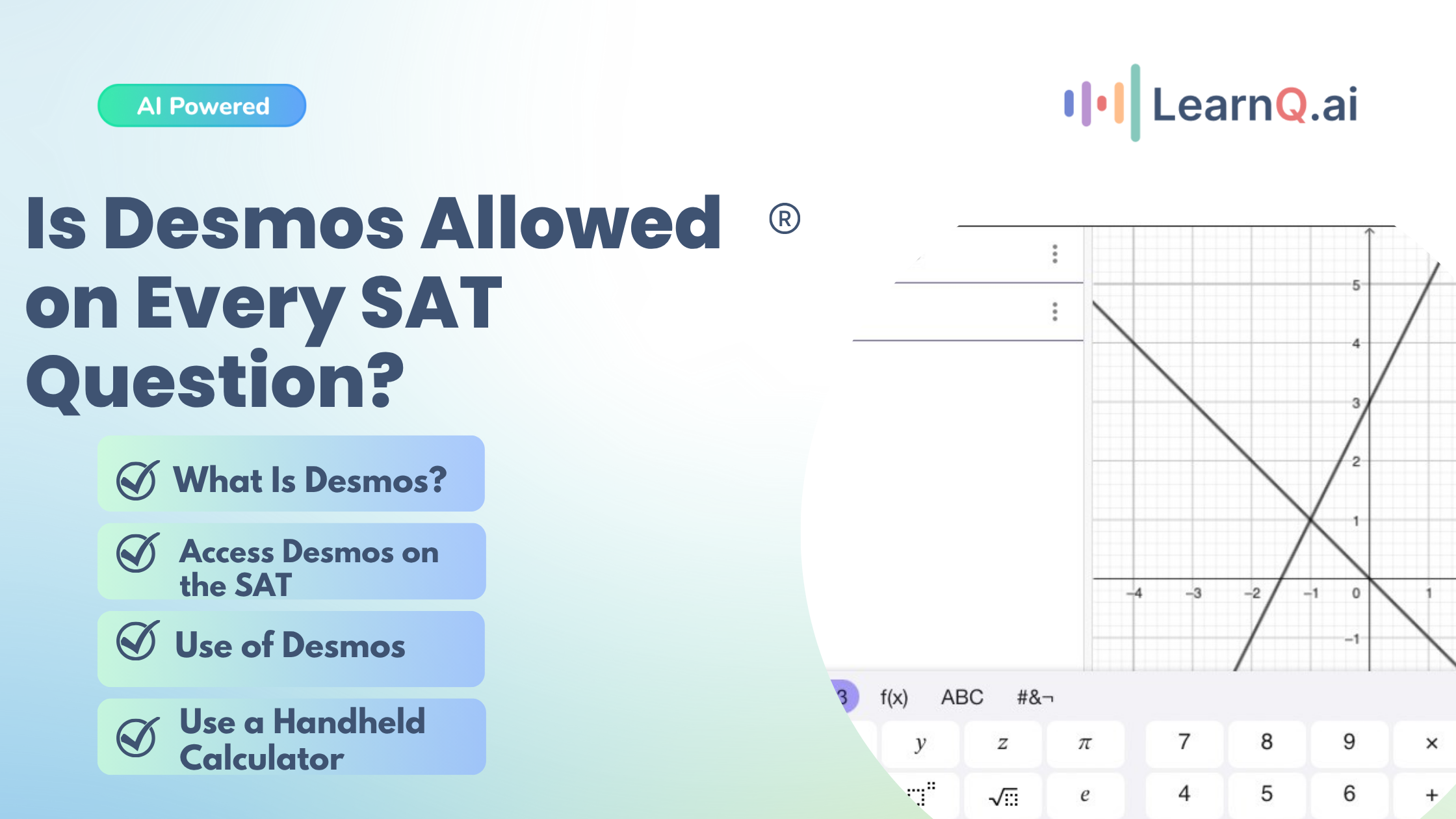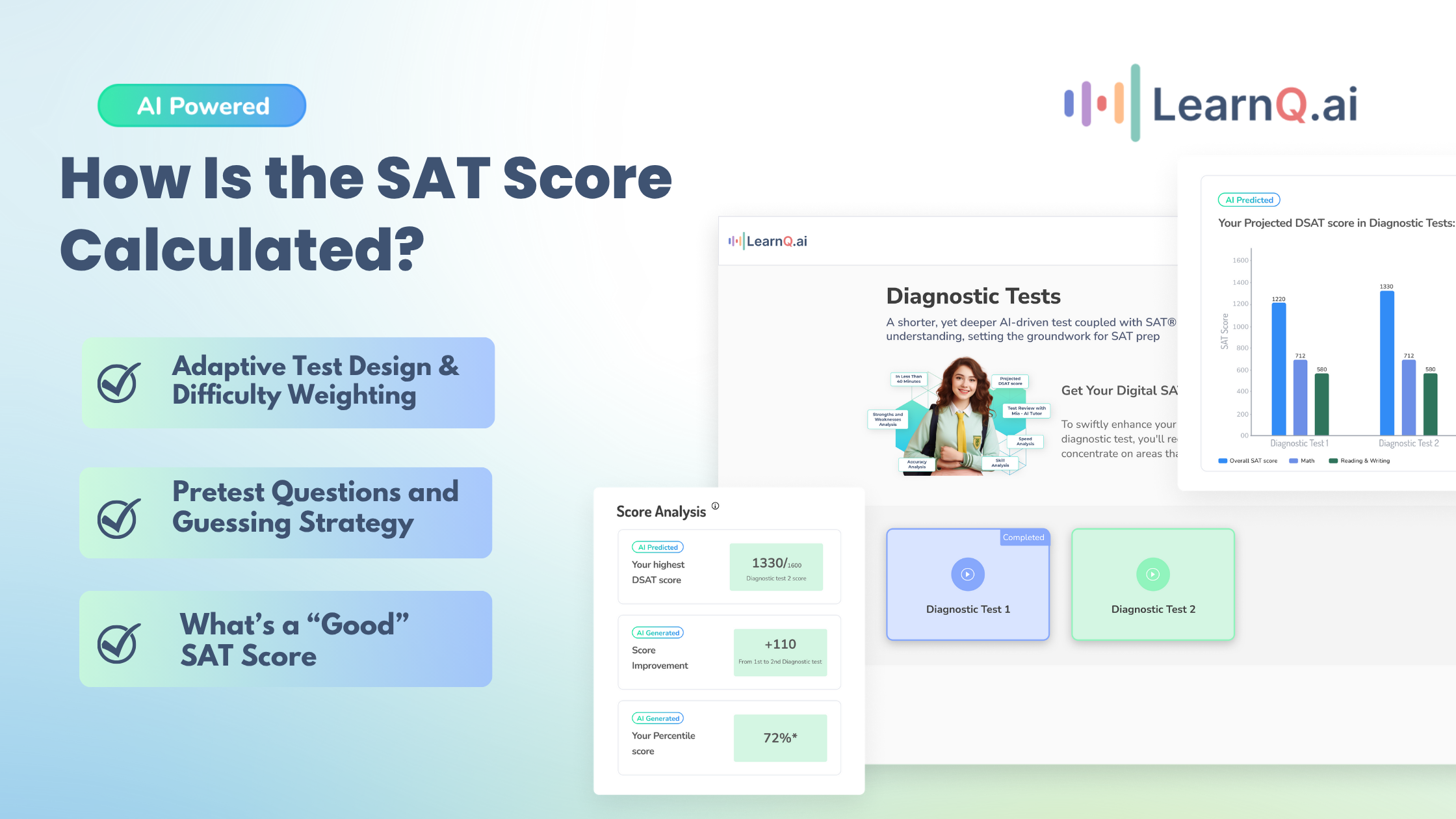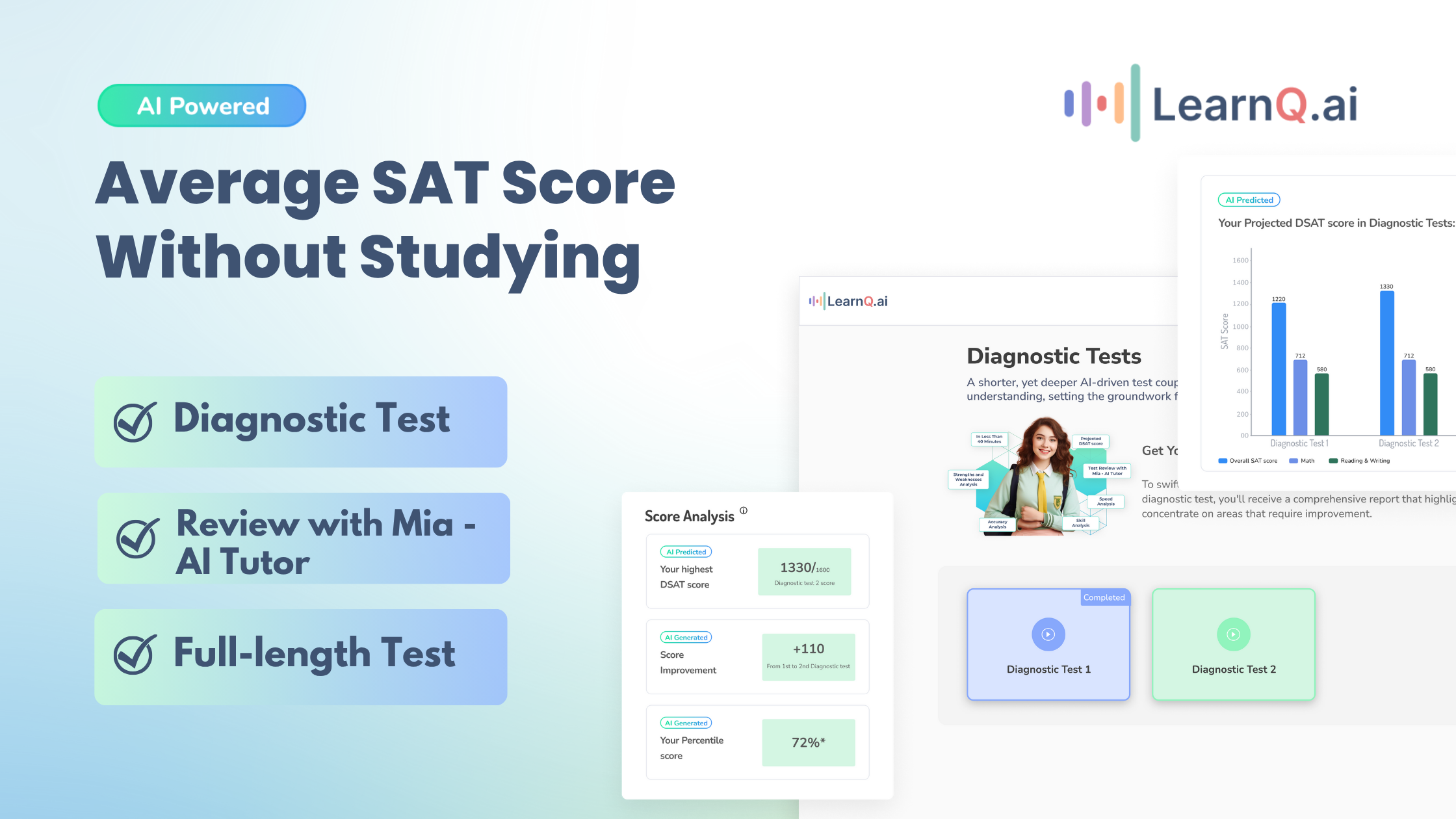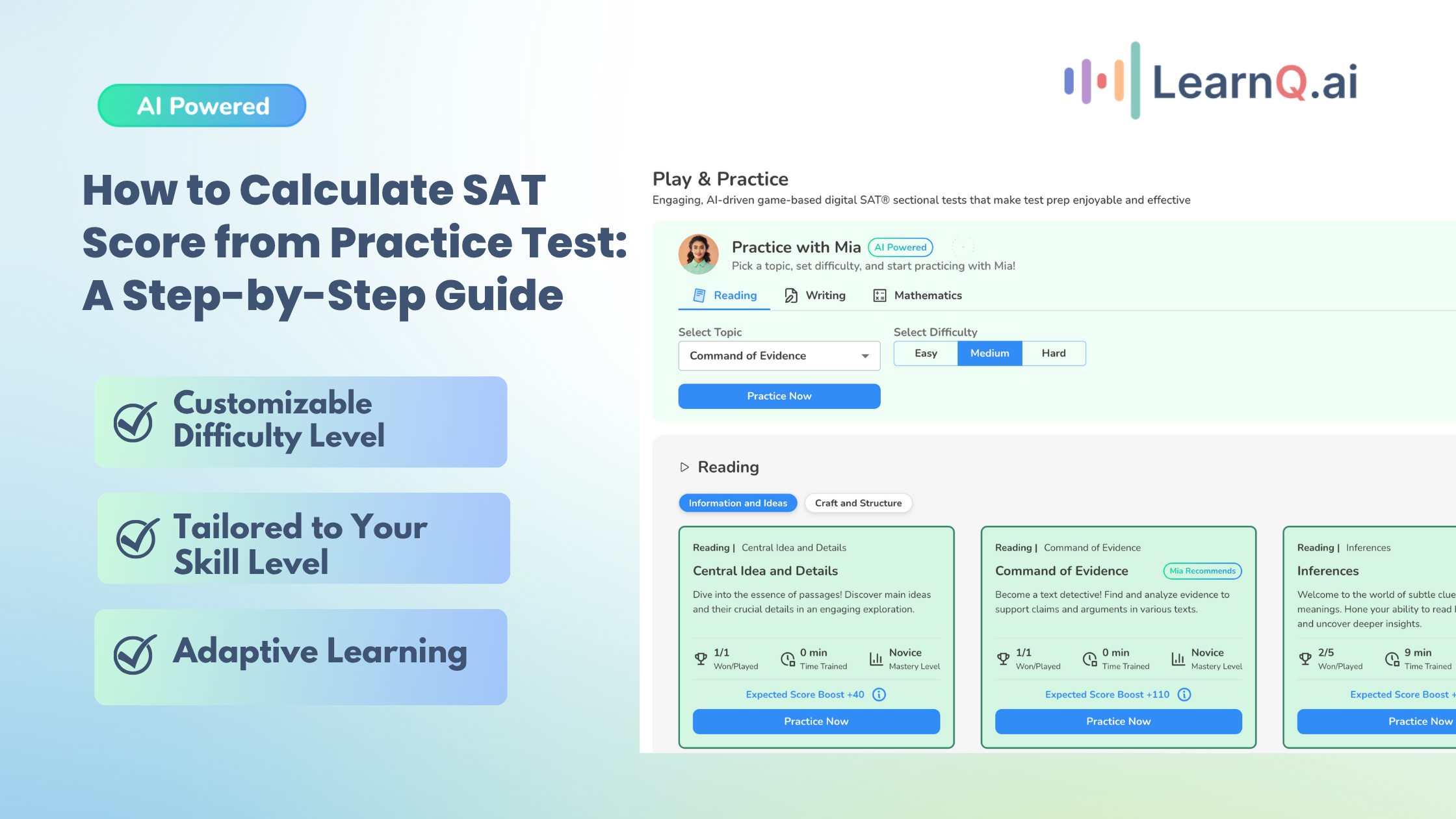If you just took the December SAT or helped students prepare, you’re likely feeling both relieved and curious about the results and the December SAT answer key.
For students, this test can be a last shot at boosting scores before college applications are due, and for teachers, it’s a time to see how well the prep paid off and what to adjust next.
At LearnQ, we understand how important this step is. We’re here to help make sense of the results, offering simple insights and tips to help students and teachers prepare for future SATs.
LearnQ.ai is Powered by VEGA AI—Is your Institute Next?
Give students a Duolingo-style test-prep platform with Shopify-level customization for tutors and institutes.
In this blog, we’ll break down the December SAT with a look at scoring, section insights, and key trends. We’ll share tips to help you use these insights for future SAT prep.
By the end of this blog, you’ll have a clear picture of how to take these results and turn them into actionable steps for a smarter SAT approach going forward.
Let’s get started!
Understanding the December SAT
The December SAT is a key test date for you as a student finalizing college applications and educators guiding SAT preparation.
Here’s a quick breakdown of the test structure, reasons students take it, and why December results are critical.
Test Structure and Format
Here’s a quick overview of the December SAT layout, including the timing, question count, and main content areas for each section:
| Section | Time (Minutes) | Number of Questions | Content Focus |
| Reading & Writing | 64 | 54 | Reading comprehension, analysis, and vocabulary. For writing grammar, punctuation, and rhetorical skills. |
| Math | 70 | 44 | Algebra, problem-solving, data analysis, advanced math concepts, functions & trigonometry. |
Common Reasons Students Take the December SAT
Many students choose the December SAT for practical reasons. Here’s why this test date is popular:
- Last-Chance Opportunity
If you’re a senior, December is often the final chance to raise your SAT score before college application deadlines.
This date gives you one last opportunity to strengthen your application.
- Targeted Improvement
If you’ve taken the SAT before, December is a great time to focus on specific areas where you need to improve.
It’s a chance to boost your score in sections where you struggled before.
- Deadline-Friendly Scores
December SAT scores are usually released in time for colleges with later deadlines or rolling admissions.
This date works well if you’re applying to schools with flexible deadlines or looking to boost your applications’ final scores.
- Benchmark for Juniors
The December SAT can be a helpful starting point if you’re a junior.
Taking the test early lets you set a baseline score and gives you an idea of what to work on for future test dates.
- Preparation for AP and Finals
December can be a good time to take the SAT because it’s close to the end of the semester, when you may already be reviewing material for AP classes or finals.
Preparing for multiple tests at once can make study time more efficient.
- Scholarship Eligibility
Many scholarships consider SAT scores, and taking the December test allows you to qualify for scholarships that require scores to be submitted by the end of the year.
Importance of December Results for College Applications
December SAT scores carry a lot of weight in the application process for multiple reasons:
- Influence on Admissions: High scores can impact final admissions decisions.
- Scholarship Eligibility: December scores can open more financial aid opportunities.
- Feedback for Educators: Results help educators adjust the curriculum before spring exams.
- Planning for Future Prep: Data informs institutions on refining prep programs for upcoming SATs.
Now that you understand the December SAT structure, let’s look at the “Result Breakdown” to see how scores are calculated and what they reveal.
Enhance your Digital SAT study routine with AI-driven insights and personalized practice tests.
Result Breakdown
Understanding the December SAT results involves knowing how the scoring system works and how scores are used for comparison and evaluation.
Here’s a clear breakdown of SAT scoring, the role of percentile ranks, and an organized table of the scoring categories.
Overview of Scoring
The SAT scoring system is clear and straightforward, giving you an overall composite score based on two main sections, plus additional detailed feedback on specific skills.
- Total Score: This ranges from 400 to 1600, combining your scores from the Evidence-Based Reading and Writing (EBRW) and Math sections.
- Section Scores: Each section, EBRW and Math, is scored on a scale from 200 to 800.
- Test Scores: Within each section, you get individual scores for Reading, Writing and Language, and Math, each on a scale of 10 to 40.
- Subscores: These range from 1 to 15 and give detailed feedback on specific skills like “Command of Evidence” and “Words in Context” in the EBRW section, and “Heart of Algebra” in Math. Subscores don’t affect your composite score but provide valuable insights for targeted improvement.
Breakdown of Scoring Categories
The table below outlines the main scoring categories for the SAT, including their ranges and descriptions of what each measures.
| Scoring Category | Score Range | Description |
| Total Score | 400–1600 | The combined score of the Evidence-Based Reading and Writing (EBRW) and Math sections. |
| Evidence-Based Reading and Writing (EBRW) | 200–800 | Assesses reading comprehension and writing skills, evaluating critical reading, grammar, and style. |
| Math | 200–800 | Tests algebra, geometry, problem-solving, and data analysis skills across calculator and no-calculator sections. |
| Test Scores | 10–40 | Individual scores for each main area, Reading, Writing and Language, and Math. |
| Subscores | 1–15 | Detailed insights into specific skills within EBRW and Math, providing feedback on particular skill areas. |
Importance of Percentile Ranks
Percentile ranks help you see how your SAT score stacks up against other test-takers, giving valuable context for college admissions:
- Relative Performance: Percentiles show where you stand compared to others. For example, scoring in the 75th percentile means you scored higher than 75% of test-takers nationwide.
- College Admissions: Colleges often look at percentile ranks along with your raw score to get a clearer picture of your performance relative to the larger applicant pool.
- Preparation Insights for Educators: Percentile ranks give educators a snapshot of student performance nationally, helping them focus on areas where students may need extra support.
Analyzing Performance by Section
Understanding each SAT section can help you focus on key areas for improvement. Here’s a concise breakdown of typical scores, common pitfalls, and skills assessed.
Evidence-Based Reading and Writing (EBRW)
Typical Score Range: 200–800
Common Pitfalls:
- Reading: Challenges with complex texts, misreading questions, and managing time.
- Writing: Difficulty identifying grammar errors and forming clear arguments with evidence.
Key Skills Assessed:
- Reading: Analyzing texts, understanding main ideas, finding details, and making inferences.
- Writing: Grammar, punctuation, sentence structure, building well-supported arguments.
Math Section
Typical Score Range: 200–800
Common Challenges:
- Word Problems: Translating words into math equations.
- Time Management: Saving enough time for complex problems.
- Algebra and Geometry: Gaps in introductory algebra and geometry.
Key Skills Assessed:
- Heart of Algebra: Linear equations, inequalities, functions.
- Passport to Advanced Math: Quadratic equations, polynomials, exponential functions.
- Problem Solving and Data Analysis: Interpreting data and solving real-world problems.
Identifying Strengths and Weaknesses
Understanding strengths and weaknesses on the SAT is key to improving performance. Here’s how to analyze individual results and how LearnQ can provide targeted insights.
Analyzalization of Individual Performance in Each Section
Look at the section scores for Evidence-Based Reading and Writing (EBRW) and Math to understand your or your students’ performance.
- For EBRW, look at Reading and Writing separately to see if issues are more with comprehension or grammar.
- For Math, identify weaknesses in algebra, geometry, or word problems.
- Check subscores like “Command of Evidence” or “Heart of Algebra” to pinpoint specific skill gaps within each section.
Strategies for Identifying Patterns in Incorrect Answers
Spotting patterns in missed questions can reveal underlying issues:
- Group Missed Questions by Type: Identify which questions are missed the most (e.g., inference in Reading, sentence structure in Writing, or algebra in Math).
- Check Timing Patterns: See if errors increase toward the end of sections, indicating time management issues.
- Spot Repeated Mistakes: Repeated mistakes in specific question types highlight key areas that need focus.
Enhance your Digital SAT study routine with AI-driven insights and personalized practice tests.
Use LearnQ for Performance Analysis and Personalized Feedback
LearnQ provides helpful tools for targeted analysis:
- Performance Tracking
Tracks your progress over multiple SAT attempts, highlighting patterns and pinpointing areas for improvement.
- Personalized Feedback
This feature of LearnQ delivers targeted feedback based on your strengths and weaknesses, guiding you to study areas that maximize score gains.
- Data-Driven Mastery
Uses real-time scores to fine-tune your learning path, focusing on mastery, time management, and accuracy to help you improve faster.
- Practice Tools
LearnQ provides timed, full-length SAT practice tests that simulate actual test conditions, helping you build pacing and accuracy.
With the result breakdown complete, let’s look at the overall trends shaping SAT performance.
Also read: Tips for Solving Problems on SAT Practice Test With Study Plan
Discussion of Overall Trends
Here’s an overview of the main trends from the December SAT results.
Overall Score Trends
Recent score data shows how SAT scores are shifting over time.
- Recent Trends: The average SAT total score for the class of 2023 dropped to 1028, down from 1050 for the class of 2022, with declines seen in both the ERW and Math sections.
- Historical Context: Over the past decade, SAT scores have varied. Some years saw increases, while others had decreases, influenced by changes in the test format, curriculum standards, and student demographics.
Factors Influencing Test Performance
Several factors can affect SAT scores, from preparation to available resources. Here’s a look at the key influences:
Preparation Strategies
Following a structured study plan, using quality materials, and getting support from a tutor can help you improve your score.
Practicing regularly, especially with timed tests, builds familiarity with the SAT format and helps you manage your time.
School Curriculum
If your school focuses on critical thinking, reading comprehension, and problem-solving, you’re likely better prepared for the SAT.
When your school’s curriculum aligns with SAT skills, you’ll feel more ready on test day.
Student Demographics
Factors like socioeconomic status, access to resources, and school support can affect your performance.
Students with more resources often have better access to prep courses, tutors, and study materials, which can make a difference.
Test Familiarity
If you’ve taken the SAT before or have access to prep materials, you’ll likely feel more comfortable with the test format.
Knowing the structure helps reduce anxiety and improves your ability to manage time.
Access to Resources
Using prep books, online tools that are all-in-one for SAT prep, like LearnQ, and classes helps you identify areas where you need more practice, especially if you don’t have access to a tutor.
Extracurricular Demands
Balancing SAT prep with other responsibilities like sports, clubs, or a job can affect your study time.
If you have fewer outside commitments, you might find it easier to focus on your prep.
Insights into Changes in Scoring Trends
Changes in the SAT format, curriculum standards, and test strategies have impacted recent scores.
Test Format Changes
Adjustments to the SAT, like removing the Essay section, have changed how scores are distributed across sections.
These changes affect how you may prioritize certain skills during prep.
Curriculum Shifts
State and national education standards updates impact the skills you bring to the SAT.
For example, stronger focus areas in school, like critical thinking or data analysis, can improve performance on specific sections.
Test-Taking Strategies
Being familiar with pacing, time management, and effective guessing strategies can boost your score.
These skills help you make the most of your time and answer accurately under test conditions.
Now that you understand the overall trends, let’s see how your December SAT results can guide future preparation.
How to Use December Results for Future Preparation
Your December SAT results can be a valuable guide for planning your next steps.
As mentioned above, setting specific goals, tailoring a study plan, and practicing strategically can maximize your results and improve your performance.
1. Setting Goals for Improvement
Setting clear goals based on your December results helps you stay focused and motivated as you work toward improvement.
- Based on your current performance, it’s essential to set achievable goals.
- Aiming too high can lead to burnout while setting too low goals will not push you to improve.
- Your December scores offer a clear starting point, making it easier to set realistic and impactful goals.
- Use the SMART goals framework to structure your improvement goals. SMART goals are:
- Specific (focused on a particular area, like increasing your Math score by 50 points),
- Measurable (so you can track your progress),
- Achievable (within your reach, considering your current level),
- Relevant (targeting areas that need improvement), and
- Time-bound (with a clear deadline, like before your next SAT attempt).
- Using LearnQ’s Goal-Setting Feature: LearnQ offers features to help you set and track these goals over time. You can use free diagnostic tests to monitor your progress and adjust your goals based on practice performance, helping you stay on track and measure your growth.
2. Tailoring Study Plans
Your study plan should be customized based on the areas identified in your December results that need improvement.
Create Personalized Study Plans Based on Performance Data
Look at your December results to identify specific sections or question types that need the most work.
Use this data to create a focused study plan that dedicates more time to those weak areas: algebra in Math or grammar in Writing and Language.
Implement LearnQ’s Adaptive Learning Feature
LearnQ’s adaptive learning feature personalizes your practice sessions.
As you complete exercises, the platform adjusts to give you questions that match your skill level and target weaker areas, ensuring that your study time is efficient and effective.
Also read: How to get started with LearnQ.ai for FREE?
3. Practice and Review Strategies
Effective practice is more than just doing exercises. It’s about targeted practice and reviewing your work to reinforce learning.
- Use your December results to identify your weakest areas and focus your practice there.
- Targeted practice helps you improve more quickly because you’re dedicating time to the skills that need attention most.
- After each practice session, review any mistakes thoroughly.
- Understand why you missed each question and what the correct approach should have been.
- This reflection reinforces correct methods and helps prevent similar mistakes in the future.
- LearnQ offers practice questions tailored to your needs and provides immediate feedback on your answers.
- This allows you to learn from mistakes in real time, reinforcing the correct approach and helping you adapt your strategy.
Using your December SAT results can help you focus on areas to improve for your next test. With a clear plan, you can boost your performance in future exams.
Preparing for Upcoming SATs
Effective preparation for the SAT involves consistent practice, realistic test simulations, and personalized feedback.
Here’s how to structure your study plan and how LearnQ can support your journey.
Tips for Ongoing Preparation
- Establish a Study Schedule: Dedicate specific times each week to focus on different sections of the SAT, ensuring a balanced approach.
- Target Weak Areas: Use previous test results to identify and concentrate on sections where improvement is needed.
- Review Mistakes Thoroughly: Analyze errors to understand misconceptions and prevent them in future tests.
Importance of Simulated Practice Tests
Engaging in full-length, timed practice tests is crucial for:
- Building Stamina: Simulating the actual test duration helps you adapt to the exam’s length and maintain focus.
- Enhancing Time Management: Practicing under timed conditions improves pacing, ensuring you can complete each section within the allotted time.
- Identifying Performance Patterns: Regular practice tests reveal consistent mistakes or timing issues, allowing for targeted improvement.
LearnQ Supports Your SAT Preparation
LearnQ offers comprehensive tools to enhance your study efforts:
- Full-Length Practice Exams
Access realistic practice tests that mirror the SAT format, helping you become familiar with the exam structure.
- Detailed Reports
Receive in-depth analyses of your performance, highlighting strengths and pinpointing areas for improvement.
- AI Tutor Mia
Benefit from personalized guidance with Mia, an AI tutor available 24/7 to clarify doubts, explain concepts, and provide tailored practice questions.
LearnQ.ai is powered by VEGA AI—Is your institute next?
Offer students a Duolingo-style test-prep platform with Shopify-level customization for tutors and institutes.






Conclusion
The December SAT results provide useful insights into where students typically do well and where they struggle.
Understanding these trends and breaking down each section can help you or your students focus on areas needing improvement.
Using tools like LearnQ can make SAT prep more effective and less overwhelming.
With personalized feedback, gamified digital SAT prep, detailed analytics, and real-time insights, LearnQ helps you see exactly where to focus, making your study time count and boosting your confidence.
Check out LearnQ to get a personalized SAT study plan that matches your strengths and weaknesses, helping you reach your full potential on test day.

